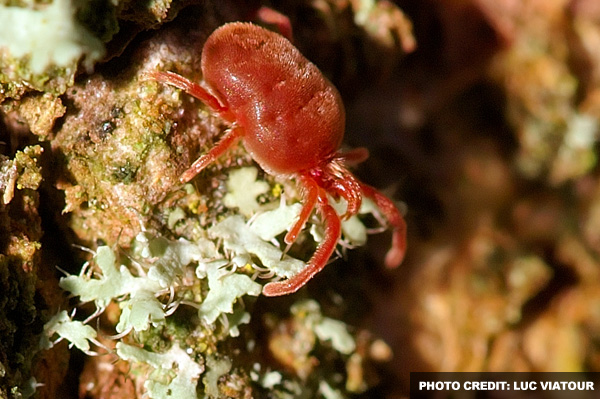Chiggers
The term chigger is a common name used to describe the larval stage of mites that are parasitic on warm-blooded animals, including people. Chigger bites characteristically cause intense itching and the formation of small, reddish welts. Chiggers are active from spring to late fall but are most numerous in early summer.
Chiggers are closely related to ticks and spiders and pass through the same four stages of development: egg, larva, nymph, and adult. Adult chiggers become active in early spring and the females deposit eggs in grassy or weedy areas. The eggs hatch into microscopic larvae (chiggers) that crawl on vegetation and attach to passing small mammals or people. They wander over the skin surface before attaching at a skin pore or hair follicle. The attachment site on people is usually in places where the clothing fits tightly over the skin or where the skin is thin or wrinkled.
Contrary to popular opinion, chiggers do not burrow into the skin nor do they feed on blood. Instead, chiggers inject a digestive fluid containing enzymes that cause skin cells to rupture. The fluids from the skin cells are then consumed as food. The injected enzymes cause the skin to become red, swollen and itchy. The itch may last for several days and will persist even after the chigger has detached from the skin.
Direct, chemical control of chiggers is usually impractical. Large areas would have to be sprayed several times for effective control. If spraying is desired, apply an outdoor insecticide according to label directions, paying special attention to areas of tall grass and weeds.
The likelihood of encountering chiggers can be reduced by applying personal insect repellents, wearing loose-fitting clothing, and avoiding sitting or reclining directly on the ground. In addition, take a hot, soapy bath or shower immediately after returning from likely chigger-infested areas to remove most chiggers before they have had the opportunity to attach and feed.
The many chigger "home remedies" used by devotees have not been tested to verify effectiveness. Most however, are misguided or developed from a incorrect understanding of chigger biology. This includes the widespread myth that using fingernail polish "kills" the embedded chigger. Relief from itching can come in many forms. One requirement for stopping itching is to seal the skin from contact with air. That's why many remedies, including nail polish appear to work. Similar results can occur with calamine, vaseline, cold cream, and baby oil. Better relief often comes from products that seal the skin and contain antihistamines; for example, caladryl or hydrocortisone salves and creams. Products that contain local anesthetics and analgesics also effectively alleviate symptoms for most people. Consult your physician or pharmacist for further assistance is choosing which product to use.

